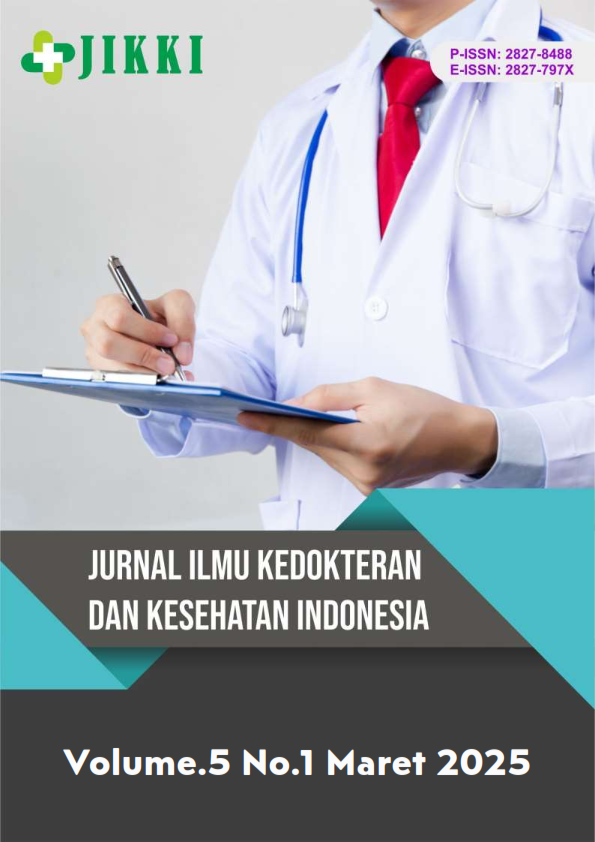Hubungan Faktor Lingkungan Fisik dan Tindakan Masyarakat dengan Kejadian Demam Berdarah Dengue (DBD) di Wilayah Kerja Puskesmas Rawasari Kota Jambi Tahun 2025
DOI:
https://doi.org/10.55606/jikki.v5i1.7216Keywords:
Community Actions, Dengue Fever, Jambi CityAbstract
Dengue Hemorrhagic Fever (DHF) is a disease caused by the dengue virus and transmitted by the Aedes aegypti mosquito. The working area of the Rawasari Health Center in Jambi City shows a trend of increasing dengue cases from year to year. This indicates that there may be other factors influencing the incidence of dengue, including physical environmental conditions and community behavior. The objective of this research is to determine the relationship between the presence of mosquito larvae in water reservoirs/containers, the action of hanging clothes, using mosquito repellent, cleaning water containers, disposing of waste items, and installing wire mesh with the incidence of dengue fever in the working area of the Rawasari Health Center in 2025. This research uses a quantitative study, with a case control design. The sample size consisted of 24 cases and 24 controls determined by matched case control study techniques based on age and gender. Data were collected through questionnaires and observation sheets, and analyzed using the chi-square test to determine the relationship between the independent variables and the incidence of dengue fever. The results show that the presence of mosquito larvae in water storage containers (p-value 0.042), practices of cleaning water storage containers (p-value 0.020), actions to eliminate waste items (p-value 0.043), and the installation of screens or mosquito nets (p-value 0.004) are significantly related to the incidence of dengue fever. Conversely, other factors such as the habit of drying clothes and the use of mosquito repellent did not show a statistically significant relationship with dengue fever cases in the study population. There is a significant relationship between the actions of cleaning water storage places and installing wire mesh. Effective prevention requires active community involvement in maintaining environmental cleanliness and consistently implementing the 3M Plus practices.
References
Adelia, R., & Nurfadilah, S. (2023). Penyakit Demam Berdarah Dengue (DBD) dan Upaya Pencegahannya. Jurnal Kesehatan Komunitas, 5(1), 35–42.
Astrada, E., Wandra, T., Tarigan, F. L., Ginting, D., Siregar, L., & Siagian, M. T. (2023). Determinan kejadian demam berdarah dengue di wilayah kerja Puskesmas Kenali Besar dan Puskesmas Rawasari Kota Jambi tahun 2022. Jurnal Ners Universitas Pahlawan, 7, 932–951.
Fadrina, S., Marsaulina, I., & Nurmaini, N. (2021). Hubungan menggantung pakaian dan memasang kawat kasa dengan kejadian demam berdarah dengue di Kabupaten Langkat. Journal of Health Sciences, 2(3), 402–409. https://doi.org/10.46799/jhs.v2i3.127
Gafur, A., & Saleh, M. (2015). Hubungan tempat penampungan air dengan keberadaan jentik Aedes aegypti di perumahan dinas type E Desa Motu Kecamatan Baras Kabupaten Mamuju Utara. Higiene, 1(2), 92–99. https://journal.uin-alauddin.ac.id/index.php/higiene/article/view/1239
Kementerian Kesehatan Republik Indonesia. (2023). Profil kesehatan Indonesia 2022. https://www.kemkes.go.id/downloads/resources/download/pusdatin/profil-kesehatan-indonesia/Profil-Kesehatan-2021.pdf
Kementerian Kesehatan. (2023). Profil kesehatan (Farida Sibuea, SKM, MSc.PH & Boga Hardhana, S.Si, M., Eds.). Kementerian Kesehatan Republik Indonesia.
Khairun Nisa, G., & Siwiendrayanti, A. (2022). Penerimaan konsep green hospital di rumah sakit pemerintah (Studi kasus RSUD Tugurejo Provinsi Jawa Tengah). Higeia: Journal of Public Health Research and Development, 6(4), 308–319. http://journal.unnes.ac.id/sju/index.php/higeia
Nugraheni, S., & Lestari, M. (2024). Upaya pemberantasan sarang nyamuk melalui edukasi kesehatan lingkungan di RW 05. Jurnal Pengabdian Kepada Masyarakat Indonesia, 5(1), 112–117.
Rahmani, T., Novianti, S., & Yogaswara, D. (2024). Faktor perilaku yang berhubungan dengan kejadian demam berdarah dengue (DBD) di Puskesmas Kahuripan Kota Tasikmalaya. Jurnal Kesehatan Komunitas Indonesia, 20(1), 5–24.
Santi, N. E., Anwar, C., & Sunarsih, E. (2023). Epidemiologi, biologi, patogenesis, manifestasi klinis, dan diagnosis infeksi virus dengue di Indonesia: Kajian literatur komprehensif. Jurnal Ilmiah Permas: Jurnal Ilmiah STIKES Kendal, 13(4), 1179–1188. https://doi.org/10.32583/pskm.v13i4.1235
Santi, S., Anggeraeni, A., & Idham, S. (2023). Hubungan faktor lingkungan dan perilaku masyarakat dengan kejadian demam berdarah dengue di wilayah kerja Puskesmas Wara Utara Kota Palopo. Jurnal Pendidikan dan Teknologi Kesehatan, 6(2), 194–200. https://doi.org/10.56467/jptk.v6i2.90
Saputra, A. U., Ariyani, Y., & Dewi, P. (2023). Faktor yang berhubungan dengan lingkungan fisik dan kebiasaan keluarga terhadap penyakit demam berdarah dengue (DBD). Jurnal ‘Aisyiyah Medika, 8(2), 283–292. https://jurnal.stikes-aisyiyah-palembang.ac.id/index.php/JAM/article/view/1119/841
Sari, E., Wahyuningsih, N. E., & Murwani, R. (2017). Hubungan lingkungan fisik rumah dengan kejadian demam berdarah dengue di Semarang. Jurnal Kesehatan Lingkungan Indonesia, 6(2), 88–95.
Sutrisno, H., & Winarti, S. (2022). Efektivitas penyuluhan kesehatan terhadap peningkatan pengetahuan pencegahan DBD. Jurnal Promotif: Jurnal Kesehatan Masyarakat, 13(1), 27–34.
Yuliana, D., & Permana, R. (2023). Analisis tindakan PSN dan kepatuhan masyarakat dalam pencegahan DBD di daerah endemis. Jurnal Ilmiah Kesehatan Komunitas, 9(3), 220–229.
Downloads
Published
How to Cite
Issue
Section
License
Copyright (c) 2025 Jurnal Ilmu Kedokteran dan Kesehatan Indonesia

This work is licensed under a Creative Commons Attribution-ShareAlike 4.0 International License.








